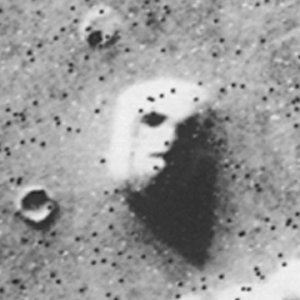 The Viking Orbiter’s picture of a hill in the Cydonia region
The Viking Orbiter’s picture of a hill in the Cydonia region
on Mars that sparked popular speculation of a
monument-building Martian civilization.
Credit: NASA/Viking
When I heard the news flash that came out in early June about the alleged discovery of standing puddles of water on Mars, a part of me was immediately skeptical. Considering how cold and thin Mars' atmosphere is known to be, standing liquid water simply cannot persist on the surface; it would either evaporate or quickly freeze-- something I've known since my earliest physics classes.
But, I have to admit, a part of me tried to imagine how there possibly might be puddles on Mars' surface-- like, maybe such puddles could be supplied by a warm spring of some kind, right? It wasn't the scientific side of me that tried to make this square peg fit in the round hole; it was the part of me that simply wants to find liquid water there...
As it turned out, no puddles were found on Mars; the claim, controversy, and retraction, which all occurred at warp speed, were a temporary blip on the radar screen of space exploration. Taken out of context, out of the bigger picture, images can easily mislead.
History is well-furnished with accounts of people who made an observation of this or that, interpreted what they saw-- and turned out to be wrong. The history of astronomy is not an exception.
